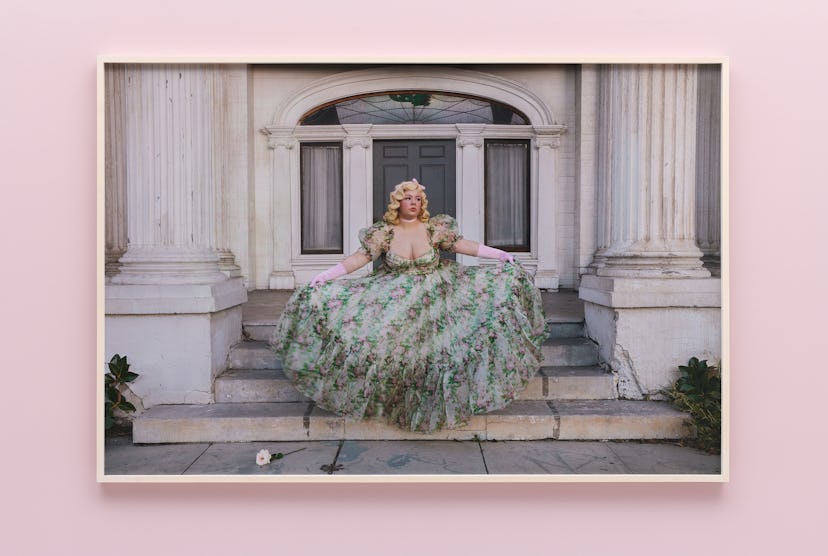Genevieve Gaignard’s Strange Fruit Means to Spark Tough Conversations About Race

“I filter what’s on my mind through my art,” the artist Genevieve Gaignard says. “Whether something is upsetting me, moving me, or bringing me joy, I think, ‘How do I process that through art to elevate it?’” America’s relationship to racial violence was top of mind when Gaignard, whose father is Black and mother is white, conceived her latest solo exhibition, Strange Fruit, which borrows its name from Billie Holiday's 1939 protest song, and is currently showing at Vielmetter art gallery in Los Angeles. Gaignard was frustrated that “conversations about race had fallen off” after the impassioned unrest in 2020, due to the killings of George Floyd and Ahmaud Arbery, had tempered. With Strange Fruit, Gaignard, whose work explores race, status, resilience, and accountability, aims to “stay in the conversation and continue the unlearning of white supremacy.”
Gaignard’s amalgam of collage, installation, sculpture, and self-portraiture featured in the show began to take shape as the artist, who started making waves in the art world in 2013, eyed materials in her L.A. studio, particularly mammy and Royal Doulton figurines. When looking at the figurines, Gaignard remembers thinking, “‘I wish I had a bunch of these.’” So, she requested a fabricator reproduce 100 mammy statuettes. "When I saw them, all lined up, I was like, ‘Damn, they’re an army.’” Her new piece, “The American Dream is a Pyramid Scheme,” features 81 custom, headless figurines on tiers. “Someone could read it as dismembering, but the figurines weren’t something we Black people made for ourselves,” she says. “This was white people making a glorified image of what it was to serve them. I felt she was stronger without her head. Removing her head was a way to take her story beyond servant and focus on her stance, what she’s conquered, and what Black people continue to conquer.”
Left: “And Still We Bloom,” (2022). Mixed media collage on panel. Right: “The American Dream is A Pyramid Scheme,” 2022. Eighty-one headless figurines on tiers, doily, vintage wallpaper on plinth.
Also from Strange Fruit, a series of new portraits titled “Off With Their Heads” feature Gaignard in nostalgic Selkie dresses as she embodies Royal Doulton figurines. “I have collected many of these, and the white women in these figurines often hold a random rose in their hand and look like a damsel in distress—but I think she’s got the control in many ways,” the artist says. Gaignard regularly takes center stage in her photographs. By casting herself—a woman who can “pass” for white but identifies as Black—she challenges viewers to examine their preconceived notions about race. “To move this conversation, I needed to position myself as a body of privilege,” she says. “I also needed to take ownership of being part of the problem. White supremacy is instilled in almost all of us. Because whiteness is portrayed specifically everywhere, even Black and Brown people view themselves negatively. So it’s almost therapeutic to see [a white damsel] in a made-up way.”
Gaignard’s practice has grown into a largely collaborative effort, and Strange Fruit is no different. To add to the staging in the photographs, Gaignard called on florist Nemuel DePaula, who made it a point to include magnolias, which grow abundantly in the south and appear in the “Strange Fruit” lyrics. The artist also called upon singer Samantha Farrell to cover “Strange Fruit” especially for the show.
But Gaignard’s collaborative leanings are one thing—the immersive nature of her exhibition is another. The scent of magnolias emanating throughout the gallery space is by design. Farrell’s rendition of “Strange Fruit” plays on repeat from a vintage jukebox. Gaignard says that racial injustice “is a big issue, a big story. It’s everyone’s story. I can’t tell it on my own.” Arguably, one of the most provocative elements of the exhibition is figurines of white womens’ heads placed on red pillows. A pink ribbon is tied around the necks of the figures as “the symbol of lynchings,” says Gaignard, who calls these works “The Apple Doesn't Fall Far From the Tree.” “The head is not supposed to be white women only,” she adds. “That head is a representation of white privilege. What does it look like for white privilege to be in the position that they’ve put others through?”
Left: “The Apple Doesn't Fall Far From the Tree (Red Delicious),” 2022. Resin figurine, pink ribbon, red satin pillow, vintage wallpaper on plinth. Right: “Off With Their Heads: I See Ghosts,” 2022. Chromogenic print.
Left: “The Apple Doesn't Fall Far From the Tree (Honey Crisp),” 2022. Resin figurine, pink ribbon, red satin pillow, vintage wallpaper on plinth. Right: “Strange Fruit in Neon,” 2022. Neon, vintage wallpaper on panel.
Elsewhere, neon works featuring the show’s title and “Salt of the Earth” are placed on vintage wallpaper, which, for Gaignard, is reminiscent of the look in her childhood home in Orange, Massachusetts. While Strange Fruit “refers to whiteness,” says Gaignard, her use of the phrase “Salt of the Earth” speaks of Black folks. “That saying refers to the real, down-to-earth people,” she says. “My interpretation is to uplift and state that Blackness is the salt of the earth. That’s really the story of Blackness. After all this shit, it’s remarkable, the resilience of Black people.”
At the opening of Strange Fruit in mid-March, Gaignard says she was approached by multiple white women who said, “‘Your work is so beautiful,’” she recalls. The comment left Gaignard “slightly disturbed,” she says. “They didn't know what else to say.” Gaignard also remembers being asked how she feels now that her collection is done. “I’m like, ‘It’s interesting you think it's done.’ No, now we have to have the hard conversations. Now the work begins.”
Gaignard’s work has been collected by the Studio Museum in Harlem and the California African American Museum, as well as by Jennifer Lopez and Tina Knowles Lawson. Strange Fruit runs through May 7 at Vielmetter Los Angeles.